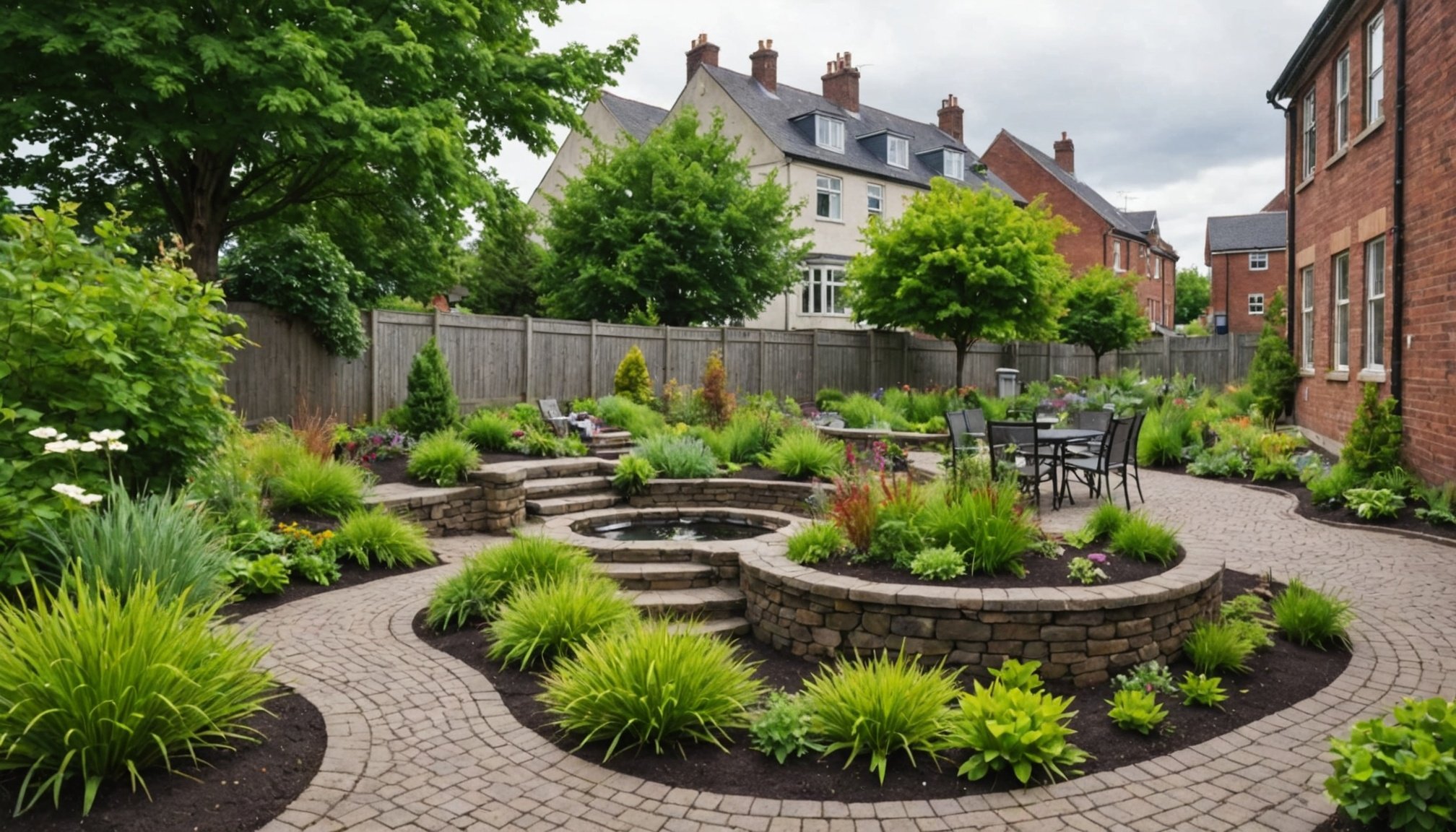Introduction to Rain Gardens
Rain gardens are a progressive approach to managing stormwater while also enhancing urban aesthetics. A rain garden is a deliberately designed landscape feature that captures and absorbs rainwater runoff from impervious surfaces like roofs, driveways, and walkways. The purpose is dual-fold: flood mitigation and pollutant filtration. Stormwater management becomes increasingly crucial in urban areas, where hard surfaces dominate and water runoff can lead to flooding. This is particularly pertinent for cities like Glasgow, where managing outdoor space effectively poses challenges due to its infrastructure and weather patterns.
The demand for efficient stormwater management in urban environments is pressing. In cities such as Glasgow, with its unique outdoor layout and high rainfall, rain gardens offer a practical solution. They serve as natural sponges, absorbing excess water, thereby reducing potential flooding and protecting water quality by filtering out pollutants.
Additional reading : Revitalize your compact sheffield kitchen: step-by-step guide to creating a thriving vertical herb garden
In summary, rain gardens provide a sustainable solution for urban areas like Glasgow to handle stormwater effectively. They not only improve environmental health but also enhance the visual appeal, increasing the aesthetic value of urban landscapes.
Benefits of Integrating Rain Gardens
Integrating rain gardens into urban environments offers numerous advantages. The environmental benefits are significant, primarily through the natural filtration of pollutants from runoff. These gardens act as bio-filters, trapping suspended particles, breaking down contaminants, and improving water quality. Furthermore, rain gardens bolster local wildlife by supporting biodiversity, creating habitats for birds, bees, and other beneficial species. They contribute to the ecosystem services by providing food and shelter.
Additional reading : Revamp your glasgow loft into a charming reading retreat: innovative ideas for avid bookworms
In addition to their ecological impact, rain gardens noticeably enhance the aesthetic value of properties. A well-designed rain garden adds visual interest and landscape diversity, boosting curb appeal and potentially increasing property values. The vibrant mix of native plants not only beautifies urban areas but connects residents with nature, promoting well-being.
These factors underscore the practicality and desirability of rain gardens in cityscapes. By integrating rain gardens, urban planners and homeowners alike can embrace a sustainable approach to landscaping that benefits both the environment and the community. As more cities recognize the value of rain gardens, it’s expected that they will become key components in urban planning for flood management and beautification efforts.
Designing a Rain Garden
Creating a functional rain garden involves a thoughtful approach to landscaping techniques. Before diving into landscaping, a comprehensive site assessment is essential. Identify a location that naturally receives runoff, such as spaces near downspouts or low-lying areas. Additionally, the ideal spot must be at least 10 feet away from the home to prevent water damage.
Site Assessment and Selection
Assessing the site requires understanding the drainage patterns and water flow. Choose an area that is neither marshy nor overly dry. Avoid placing rain gardens over septic systems or under large trees.
Soil Considerations
Soil type significantly influences a rain garden’s success. Conduct a soil test to determine its permeability and drainage capacity. Ideally, a mix of sand, compost, and topsoil ensures proper absorption and filtering of stormwater.
Plant Selection and Placement
Choose native plants suited to Glasgow’s climate. These are adapted to local conditions and require less maintenance. Strategically place plants based on their water tolerance, with those needing more moisture at the lowest point of the garden layout. This thoughtful plant placement promotes effective filtering and enhances biodiversity.
Designing a rain garden using these steps ensures a balance of aesthetics and functionality.
Implementation Steps
Embarking on rain garden construction is a rewarding venture. The process begins with gathering necessary tools and materials. Essential items include a shovel, wheelbarrow, measuring tape, and soil amendments like compost. These help craft a garden capable of managing stormwater effectively.
Start by outlining the garden layout with string and stakes to define its boundaries. Dig to the required depth, generally 12 to 24 inches, to accommodate plant roots and water retention. A gentle slope enhances water flow towards the garden’s centre, where moisture-loving plants thrive. Layering with gravel improves drainage, while compost enhances soil permeability.
Avoid common pitfalls during installation. Ensure the rain garden is not too close to a home, preventing water damage. Steer clear of compacting soil with heavy foot traffic, as this impedes water absorption.
Incorporating soil specific to Glasgow’s outdoor spaces is vital. A mixture of sand, compost, and native topsoil facilitates filtration and nutrient retention. This thoughtful composition yields a robust rain garden, ready to tackle urban stormwater challenges. With proper planning and execution, rain gardens contribute significantly to sustainable urban landscapes.
Maintenance of Rain Gardens
Regular rain garden maintenance is pivotal to ensure sustainability and effectiveness. Key practices involve routine monitoring and upkeeping, essential for thriving garden spaces. Seasonal care requires attention to both plants and the overall garden structure. During the growing season, consistent weeding and mulching help maintain plant health, allowing for vigorous growth and efficient stormwater absorption.
In winter, seasonal considerations pivot towards protecting plant roots and ensuring drainage systems remain unobstructed by debris or ice. Addressing drainage issues swiftly is imperative. Ponding water can lead to plant damage and reduced stormwater management capabilities.
Monitoring and correcting drainage involves regularly inspecting inlet areas and ensuring that overflow paths are clear. Adjustments may be needed based on water flow observations. Introducing sustainability practices, such as using organic mulches or drought-resistant species, enhances resilience against climate variations.
An effective upkeep schedule includes monthly inspections, particularly after heavy rainfall. This approach not only boosts ecosystem services but also prolongs the rain garden’s lifespan. By adhering to comprehensive maintenance practices, homeowners and urban planners alike can maximize the environmental and aesthetic benefits provided by rain gardens in urban areas like Glasgow.
Case Studies and Local Examples
Exploring Glasgow rain gardens provides valuable insights into community projects and success stories. The city, known for its high rainfall, has witnessed numerous effective implementations that have inspired further adoption.
Successful Projects in Glasgow
One of the standout projects is at the Clyde Gateway, a transformed industrial site now thriving with sustainable landscapes. This initiative not only helps in stormwater management but also enhances the urban environment by integrating green spaces. Another example is the Pollok Park Rain Garden, serving as a model for urban stormwater management while adding aesthetic value to the park’s landscape.
Community Involvement and Benefits
Community involvement plays a pivotal role in the success of these Glasgow rain gardens. Local groups and residents frequently participate in planting and maintenance, fostering a sense of ownership and pride. This hands-on approach also promotes awareness and understanding of the environmental benefits rain gardens provide, such as water quality improvement and biodiversity enhancement.
Testimonials from Homeowners and Designers
Homeowners and landscape designers who’ve embraced rain gardens often share positive testimonials. They note not only improvements in stormwater management but also increased property values and community cohesion. Their experiences serve as motivating examples for others considering similar sustainable designs in Glasgow’s unique outdoor spaces.
Local Environmental Regulations
Understanding the local regulations surrounding rain garden installation is crucial for compliance and sustainability. Environmental law in Glasgow includes guidelines for managing water runoff and protecting local ecosystems. Homeowners keen on integrating these features must familiarize themselves with permits and planning permissions, ensuring their garden design aligns with municipal requirements.
When creating a rain garden, it’s essential to adhere to Glasgow’s regulations on stormwater management. These rules aim to minimize flood risks and enhance water quality by promoting sustainable landscaping techniques. Guidelines may include restrictions on altering natural watercourses or requirements for permeable surfaces, safeguarding both urban infrastructure and biodiversity.
Complying with these regulations involves understanding local environmental standards. Homeowners can access resources like government websites or consult with city planners for precise information. Additionally, organizations provide workshops and guidance on sustainable practices, equipping residents with knowledge on adhering to legal frameworks while maximizing environmental benefits.
By adhering to local laws and standards, individuals not only protect natural resources but also contribute positively to Glasgow’s outdoor spaces, promoting cleaner waterways and greener communities. Engaging with these environmental regulations is vital for a harmonious balance between urban development and ecosystem health.
Inspiring Action: Getting Started with Rain Gardens
Engaging with rain gardens is a fantastic opportunity for communities to enhance urban landscapes. Community engagement plays a crucial role in spreading awareness and initiating sustainable practices. Glasgow offers numerous chances for individuals to learn more through gardening workshops. These events provide hands-on experience, helping participants understand the essentials of creating and maintaining rain gardens. Local organizations are at the forefront, supporting rain garden initiatives and encouraging public involvement.
To bolster efforts, it’s important to connect with local resources. Participating in workshops or seminars is an excellent way to meet experts who can offer guidance on planning and implementation. Connecting with professionals can clarify which gardening techniques are best suited to local conditions and how to meet environmental standards.
By actively seeking these educational opportunities, you contribute to a sustainable future for Glasgow’s unique outdoor spaces. Learning from others and sharing experiences can inspire more people to contribute to this eco-friendly movement. In essence, rain gardens present not only a method for effective stormwater management but also a community-driven approach to enhancing local biodiversity and aesthetics.





